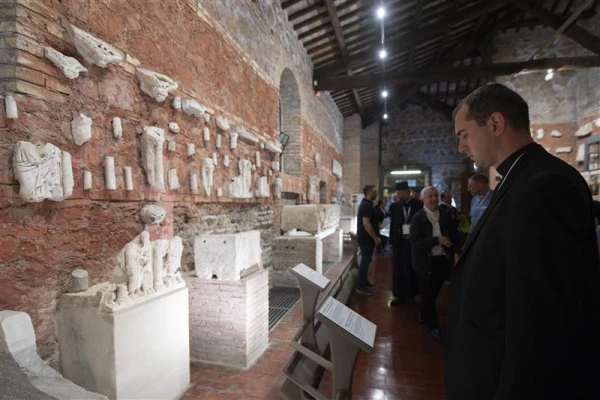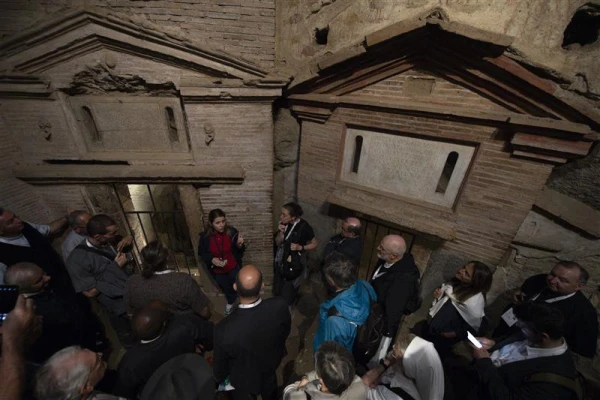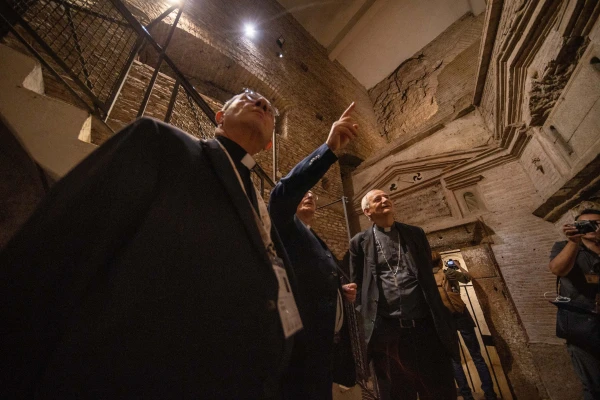Vatican City, Oct 13, 2023 / 15:57 pm
Synod on Synodality delegates made a pilgrimage to Rome’s catacombs Thursday where they literally “walked together” to the tombs of early Christian martyrs.
Hundreds of delegates took a break from their discussions of synodality to visit the catacombs of St. Sebastian and St. Callistus located on Rome’s ancient Appian Way on Oct. 12.
Each synod delegate was given a copy of the “Pact of the Catacombs,” translated into four languages, when they arrived at the Basilica of St. Sebastian Outside of the Walls for the opening prayer of the pilgrimage. The pact, signed by 42 bishops in 1965 during the Second Vatican Council, was not referred to by any of the speakers during the synod pilgrimage but provided as “meditation material,” Vatican spokesman Matteo Bruni told CNA.
Synod on Synodality delegates are literally “walking together” today on a pilgrimage along Rome’s ancient Appian Way to the catacombs of Saint Sebastian. pic.twitter.com/HnKhNW0bLx
— Courtney Mares (@catholicourtney) October 12, 2023
Before the synod delegates descended into the dark tunnels of the catacombs, Cardinal Jean-Claude Hollerich, the relator general of the Synod on Synodality, led them in spiritual reflection and invited them to recite the Apostles’ Creed together inside the basilica.
“The places we will encounter on our journey remind us of the radical nature of following the Lord and strengthen our communion with those who have ‘gone before us marked with the sign of faith,’ up to the gift of life,” Hollerich said.
The cardinal added that tradition holds that the relics of both St. Peter and Paul were kept in the catacombs of St. Sebastian in the third century during the Roman Empire’s persecution of Christians. He noted that the Church’s solemnity of Sts. Peter and Paul on June 29 marks the anniversary of the translation of their relics.

The underground tunnels of the catacombs were used as burial grounds for early Christians, who decorated its stone walls with Christian symbols, including a fish, a dove, and the Chi Rho symbol.
In addition, more than 600 ancient graffiti inscriptions invoking Sts. Peter and Paul have been found within the catacombs of St. Sebastian.
After the prayer, the delegates were split into three groups with some traveling by bus to visit the nearby catacombs of Domitilla and St. Callistus.

Cardinals, bishops, and lay delegates walked in single file down the catacombs’ narrow tunnels past burial niches carved into the stone walls, making their way along the dirt floors mostly in silence.
An archaeological guide provided some historical explanations and answered questions during the catacombs visit, explaining that the early Christians gathered within the catacombs for funeral rites and to honor the martyrs, rather than as a hiding place, as the Roman leaders were aware of their existence.
The catacombs of St. Callistus were a burial ground for many of the Church’s first popes, including St. Anterus (235–236), St. Lucius (253–254), St. Sixtus II (257–258), and St. Eutychian (275–283). The catacombs fell into disuse after all of the relics were translated to different churches in Rome but were rediscovered in the mid-19th century by an Italian archaeologist.

(Story continues below)
The catacombs of Domitilla span nearly nine miles of tunnels and once included more than 26,000 tombs. It was after a Mass in the catacombs of Domitilla that 42 Catholic bishops signed the “Pact of the Catacombs” on Nov. 16, 1965, near the end of the Second Vatican Council.
In the 12-point text of the pact provided to the synod delegates, the bishops committed themselves to avoid wealth and to renounce symbols of power.
The 1965 pact, which included many Latin American bishops, is said to have had an influence on the development of “liberation theology,” much of which has been condemned by the Church.
During the Synod on the Amazon in 2019, Cardinal Claudio Hummes and about 40 other bishops went to the Catacombs of Domitilla and signed a two-page document called the “Pact of the Catacombs for the Common Home,” which called for “a Church with an Amazonian face, poor and servant, prophetic and Samaritan.”
Unlike in 2019, the visit to the catacombs during this year’s synod was not optional but an obligatory excursion. An unnamed Vatican source told the French Catholic news agency La Croix that the text of the “Pact of the Catacombs” was given to the delegates because “its spirit is close to that of the synod,” with another adding “it is not by chance that we took them there.”
Hollerich joked in his speech to Synod on Synodality delegates on Oct. 13: “It is not good to get lost in the catacombs and it is not good to get lost in the synod.”






